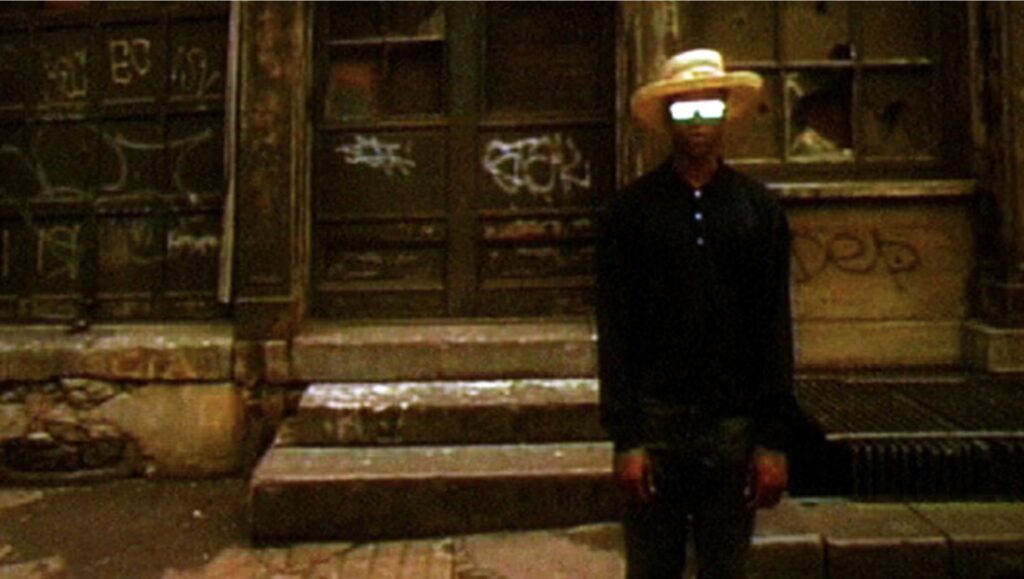
PRIMARY MATERIALS
The Last Angel of History (1996) (approx. 45 mins. running time) on Vimeo.
The Last Angel of History (1996) (approx. 45 mins. running time) on YouTube.
[Both the YouTube and the Vimeo embedded links are to the same film. I am just providing 2 links on 2 different platforms in case one goes down…]
SECONDARY MATERIALS
Downloadable pdf of chapters excerpted from Kodwo Eshun, More Brilliant than the Sun: Adventures in Sonic Fiction. We are reading (excerpted in the above) the following sections:
“OPERATING SYSTEM FOR THE REDESIGN OF SONIC REALITY” (pp. 000-007-00-001) (chapter 0, pp. 1-7)
“SAMPLADELIA OF THE BREAKBEAT” (pp. 03-023-03-043 (chapter 3, pp. 23-43)
This is a downloadable pdf of Chapter 3 of Ytasha L. Womack’s book, _Afrofuturism_ (which we also read in Week 0). Please skim or abridge your reading of this chapter *if it feels like too much reading for this week*. (That said, both the Eshun and the Womack are quite fun/untaxing reads…) Remember that the entire book is also available as an e-book from the Hampshire College Library (and other FC libraries), through ProQuest e-book central (if you would rather read online).
READING AND LOOKING QUESTIONS
Downloadable file with questions (also below).
John Akomfrah, dir., The Last Angel of History (1996)
- The film starts at the cultural symbol or topos of the crossroads. What does the crossroads symbolize in West African and American culture?
- What do you make of the figure or character of the data thief, who plays a central role in the film’s frame narrative? How to make sense of the fact that he is at once a criminal or an outlaw and an artistic or a creative force?
- Thinking back on the work we did with W.E.B. Du Bois’s posters created for the 1900 Paris Exposition, what connections can we draw between Du Bois (in 1900) and the data thief in Akomfrah’s film? Can we describe Du Bois as a kind of “data thief” in or for his own time?
- What is the significance of the fragment (in The Last Angel, the data thief is described as stealing fragments) and other related forms or practices? Scratching, sampling, collage, etc. Describe how and where we see an interest in scratching/sampling, working with the fragment, etc., running through both Akomfrah’s film and Eshun’s writing?
- When Black DJs and hip-hop artists in the US first elevated scratching and sampling to an art form (beginning in the 1970s, though some accounts will differ) it was a radical move. (It is hard to explain just how radical to a generation born almost 40 years later…) Sampling had aesthetic consequences, but also philosophical ones. It changed the way people thought about and experienced creativity, originality, authorship, cultural references and influences, property and appropriation, the very building blocks of art and music. Are you able to come up with an analogy or analogies with a more recent technological intervention that is transforming culture in a similar way?
- The brilliant American cultural critic Greg Tate (whose work we will also read a bit later), describes sampling as “digitized race memory” in the film. While sampling is a technology that is (obviously) available to everyone, regardless of race or other elements of their identity, Tate suggests with this comment that sampling is of particular importance for Black people. Why/what do you think he means by this?
- The nameless narrator (played by Edward George, another member of the Black Audio Film Collective, who also wrote the film) refers at one point to a “techno fossil.” Imagine you have found yourself flashed 100 years into the future and you have found a “techno fossil” with connections to our present moment that you need to explain to your future friends (who are not familiar with life in the year 2024). Describe your techno fossil and how you will explain its significance (or lack thereof) to your 3024 friends…
- The narrator at one point states: “The line between social reality and science fiction is an optical illusion.” Imagine that you are talking to your mom, or to your little sister, or to a well-meaning aunt or uncle, who has never thought about Afrofuturism before. Explain to this person what this statement means, using ideas, quotes, or images drawn from the film. What would you say to them?
Go the extra mile and know something about the filmmaker and his context:
–Before making this film, John Akomfrah became famous as a founding member of an art and media collective called the Black Audio Film Collective. Who are/were the Black Audio Film Collective and what kind/s of work did they make?
–What was their first and probably most famous film? (Hint: It was made in 1986.)
–Do most Black Britons (or people who identify as Black in Britain) trace their heritage to Africa through Africa-to-Britain immigration, or do most Black Britons trace their heritage to the Caribbean? (Note: New immigration trends are already changing this answer, but historically one group has dominated…)
–Who/what is the story of the generation known as “The Windrush Generation” in Britain?
–What year did The Empire Windrush make its famous voyage to England from Jamaica?
–Why did the passengers come/why were they brought?
–What was the impact of their arrival on race relations?
–True or False. Not all people who are Black Britons or who identify as Black in England or in Britain are Afro-descendant or have African heritage. In England/Britain, people who have South Asian heritage (who come from India, Pakistan, or Bangladesh) may also identify as Black.
–True or False. Black Britons who trace their heritage to Africa through direct Africa-to-Britain immigration and Black Britons who trace their heritage to the Caribbean live in perfect harmony in cities like London and Birmingham.
–True or False. The majority of the population of London are not English or do not identify as English.